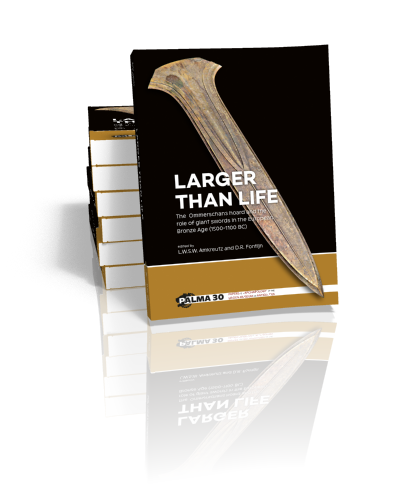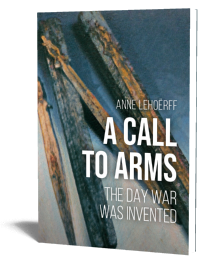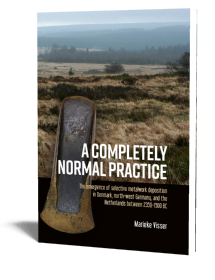Larger than Life
The Ommerschans hoard and the role of giant swords in the European Bronze Age (1500-1100 BC)
Edited by Luc W.S.W. Amkreutz & David Fontijn | 2024

Larger than Life
The Ommerschans hoard and the role of giant swords in the European Bronze Age (1500-1100 BC)
Edited by Luc W.S.W. Amkreutz & David Fontijn | 2024
Paperback ISBN: 9789464262605 | Hardback ISBN: 9789464262612 | Imprint: Sidestone Press | Format: 210x280mm | 380 pp. | Papers on Archaeology of the Leiden Museum of Antiquities 30 | Series: PALMA | Language: English | 44 illus. (bw) | 169 illus. (fc) | Keywords: Bronze Age; sword; deposition; aggrandizing; craft; hoard; ritual; weapon; dirk; Europe; warfare; trade; offering | download cover | DOI: 10.59641/0qx6bvsr
Read online 572 times
- Digital & Online access
-
Buy via Sidestone (EU & UK)
-
Buy via our Distributors (WORLD)
For non-EU or UK destinations you can buy our books via our international distributors. Although prices may vary this will ensure speedy delivery and reduction in shipping costs or import tax. But you can also order with us directly via the module above.
UK international distributor
USA international distributor
-
Bookinfo
Paperback ISBN: 9789464262605 | Hardback ISBN: 9789464262612 | Imprint: Sidestone Press | Format: 210x280mm | 380 pp. | Papers on Archaeology of the Leiden Museum of Antiquities 30 | Series: PALMA | Language: English | 44 illus. (bw) | 169 illus. (fc) | Keywords: Bronze Age; sword; deposition; aggrandizing; craft; hoard; ritual; weapon; dirk; Europe; warfare; trade; offering | download cover | DOI: 10.59641/0qx6bvsr
Read online 572 times

We will plant a tree for each order containing a paperback or hardback book via OneTreePlanted.org.
In 1896 a remarkable hoard was discovered near Ommerschans in the eastern Netherlands that included a spectacular object: a giant bronze sword. It was obtained by the landowner and kept by a forester, until it was first documented by archaeologist J.H. Holwerda in 1927. For over 85 years it remained in private ownership and inaccessible to science. Over time this sword, or rather dirk, would prove not to be a singular exception. Instead it is now part of a select family of six discovered in England (Oxborough and Rudham), France (Plougrescant and Beaune) and the Netherlands (Jutphaas and Ommerschans). In 2017 the Ommerschans hoard was obtained by the Dutch National Museum of Antiquities, bringing all six into the public domain.
The Plougrescant-Ommerschans type swords are some of the most spectacular finds of the European Bronze Age. They are extremely rare, beautiful, expertly crafted and too large and heavy to wield as weapons. Furthermore, their strong resemblance seems to have been crucial, as all six are extremely alike in design, decoration, metal composition and size (with the exception of Jutphaas). But why?
This book aims to unravel some of the mysteries surrounding this exceptional group of larger-than-life Bronze Age blades. It offers a detailed overview of the discovery and find context of the Ommerschans hoard, as well as a physical description and analysis of all finds. Also included is a comparative overview of the other five swords, including the primary publication of the Rudham dirk. The findings are subsequently interpreted focusing on their contextualisation within Bronze Age deposition practices, the importance of the visual cohesion of this group, the power and role of aggrandised objects and their potential purpose within the social and metaphysical realm of Bronze Age communities.
1. Introduction
Luc Amkreutz and David Fontijn
Part I The Ommerschans hoard. History and context
2. The one that got away: The Ommerschans hoard – found, lost and found again
Luc Amkreutz
3. ‘A nasty den of ghostly apparitions’: The site in its natural and archaeological context
Joris Brattinga and Luc Amkreutz
4. The hoard with dirk from Ommerschans: Reconstruction of the place of deposition
Corrie Bakels
Part II The Ommerschans finds. Description and object research
5. The Ommerschans sword: A description
Luc Amkreutz and David Fontijn
6. The making of the dirk: What can chemical analysis and imaging techniques tell us?
Ineke Joosten, Luc Megens, Tonny Beentjes, Luc Amkreutz, Yueer Li and Lambert van Eijck
7. Replicating the Ommerschans sword: Interview with a bronze smith
Karsten Wentink, Luc Amkreutz and Jeroen Zuiderwijk
8. Not at all random: Description of the small objects in the Ommerschans hoard
Luc Amkreutz and David Fontijn
9. About the great little objects in the Ommerschans hoard: A study into the metal composition, corrosion and wear
Bertil van Os, Liesbeth Theunissen, Ineke Joosten and Luc Megens
10. Shine on you crazy diamond: Functional analysis of the stone and flint tools from the Ommerschans hoard
Karsten Wentink, Annelou van Gijn and Ineke Joosten
Part III Interpreting aggrandised objects and deposition. Origins, parallels and perspectives
11. Does size matter? The Jutphaas find – a dirk-sized ceremonial Bronze Age object and its aggrandised counterparts
David Fontijn and Luc Amkreutz
12. The French dirks: Plougrescant and Beaune
Rolande Simon-Millot and Léonard Dumont
13. British ceremonial weapons revisited: A new Plougrescant-Ommerschans dirk from East Rudham, Norfolk, and its typological, geochemical and landscape context
Stuart Needham and Neil Wilkin
14. A comparative metallurgical analysis of the six dirks of Plougrescant-Ommerschans type
Liesbeth Theunissen and Bertil van Os
15. Unfinished business? Blunt questions about the Caistor-St-Edmund–Melle rapiers
Eugène Warmenbol
16. Aggrandised axes at the end of the Early Bronze Age in Central Europe: The hoard from Kläden in Saxony-Anhalt
Regine Maraszek
17. Strange by design: The Tollebeek spearhead revised
Valerio Gentile and Bastiaan Steffens
Part IV Synthesis
18. Religion and metal rush: Deposition of valuables from the Neolithic to the Bronze Age in Scandinavia
Helle Vandkilde
19. Larger than life: Interpreting the Ommerschans hoard
Luc Amkreutz and David Fontijn
List of authors

Prof. Dr. Luc W.S.W. Amkreutz
Since 2008 Luc Amkreutz has been the curator of Prehistory at the Dutch National Museum of Antiquities (RMO). Apart from numerous exhibitions, he worked on the 2011 new permanent exhibition ‘Archaeology of the Netherlands’, offering a fresh perspective on 300,000 years of the country’s history. He also co-created the exhibition ‘Cutting Edge Past’ in 2016 which ultimately led to the acquisition of the Ommerschans dirk in 2017. Amkreutz was appointed professor of Public Archaeology at the Faculty of Archaeology, Leiden University in 2022.

Prof. dr. David Fontijn
David Fontijn (1971-2023) was professor in the Archaeology of Early Europe at the Faculty of Archaeology, University of Leiden, the Netherlands. His research dealt with the early agrarian societies of Europe from prehistory up until the early historical period, with a particular focus on the Bronze and (early) Iron Age, the exchange and deposition of metalwork and the archaeology of so-called ritual landscapes. He led the NWO-VICI project ‘Economies of Destruction’ investigating the puzzling destruction of valuable objects in Bronze Age Europe (2015-).
Abstract:
In 1896 a remarkable hoard was discovered near Ommerschans in the eastern Netherlands that included a spectacular object: a giant bronze sword. It was obtained by the landowner and kept by a forester, until it was first documented by archaeologist J.H. Holwerda in 1927. For over 85 years it remained in private ownership and inaccessible to science. Over time this sword, or rather dirk, would prove not to be a singular exception. Instead it is now part of a select family of six discovered in England (Oxborough and Rudham), France (Plougrescant and Beaune) and the Netherlands (Jutphaas and Ommerschans). In 2017 the Ommerschans hoard was obtained by the Dutch National Museum of Antiquities, bringing all six into the public domain.
The Plougrescant-Ommerschans type swords are some of the most spectacular finds of the European Bronze Age. They are extremely rare, beautiful, expertly crafted and too large and heavy to wield as weapons. Furthermore, their strong resemblance seems to have been crucial, as all six are extremely alike in design, decoration, metal composition and size (with the exception of Jutphaas). But why?
This book aims to unravel some of the mysteries surrounding this exceptional group of larger-than-life Bronze Age blades. It offers a detailed overview of the discovery and find context of the Ommerschans hoard, as well as a physical description and analysis of all finds. Also included is a comparative overview of the other five swords, including the primary publication of the Rudham dirk. The findings are subsequently interpreted focusing on their contextualisation within Bronze Age deposition practices, the importance of the visual cohesion of this group, the power and role of aggrandised objects and their potential purpose within the social and metaphysical realm of Bronze Age communities.
Contents
1. Introduction
Luc Amkreutz and David Fontijn
Part I The Ommerschans hoard. History and context
2. The one that got away: The Ommerschans hoard – found, lost and found again
Luc Amkreutz
3. ‘A nasty den of ghostly apparitions’: The site in its natural and archaeological context
Joris Brattinga and Luc Amkreutz
4. The hoard with dirk from Ommerschans: Reconstruction of the place of deposition
Corrie Bakels
Part II The Ommerschans finds. Description and object research
5. The Ommerschans sword: A description
Luc Amkreutz and David Fontijn
6. The making of the dirk: What can chemical analysis and imaging techniques tell us?
Ineke Joosten, Luc Megens, Tonny Beentjes, Luc Amkreutz, Yueer Li and Lambert van Eijck
7. Replicating the Ommerschans sword: Interview with a bronze smith
Karsten Wentink, Luc Amkreutz and Jeroen Zuiderwijk
8. Not at all random: Description of the small objects in the Ommerschans hoard
Luc Amkreutz and David Fontijn
9. About the great little objects in the Ommerschans hoard: A study into the metal composition, corrosion and wear
Bertil van Os, Liesbeth Theunissen, Ineke Joosten and Luc Megens
10. Shine on you crazy diamond: Functional analysis of the stone and flint tools from the Ommerschans hoard
Karsten Wentink, Annelou van Gijn and Ineke Joosten
Part III Interpreting aggrandised objects and deposition. Origins, parallels and perspectives
11. Does size matter? The Jutphaas find – a dirk-sized ceremonial Bronze Age object and its aggrandised counterparts
David Fontijn and Luc Amkreutz
12. The French dirks: Plougrescant and Beaune
Rolande Simon-Millot and Léonard Dumont
13. British ceremonial weapons revisited: A new Plougrescant-Ommerschans dirk from East Rudham, Norfolk, and its typological, geochemical and landscape context
Stuart Needham and Neil Wilkin
14. A comparative metallurgical analysis of the six dirks of Plougrescant-Ommerschans type
Liesbeth Theunissen and Bertil van Os
15. Unfinished business? Blunt questions about the Caistor-St-Edmund–Melle rapiers
Eugène Warmenbol
16. Aggrandised axes at the end of the Early Bronze Age in Central Europe: The hoard from Kläden in Saxony-Anhalt
Regine Maraszek
17. Strange by design: The Tollebeek spearhead revised
Valerio Gentile and Bastiaan Steffens
Part IV Synthesis
18. Religion and metal rush: Deposition of valuables from the Neolithic to the Bronze Age in Scandinavia
Helle Vandkilde
19. Larger than life: Interpreting the Ommerschans hoard
Luc Amkreutz and David Fontijn
List of authors

Prof. Dr. Luc W.S.W. Amkreutz
Since 2008 Luc Amkreutz has been the curator of Prehistory at the Dutch National Museum of Antiquities (RMO). Apart from numerous exhibitions, he worked on the 2011 new permanent exhibition ‘Archaeology of the Netherlands’, offering a fresh perspective on 300,000 years of the country’s history. He also co-created the exhibition ‘Cutting Edge Past’ in 2016 which ultimately led to the acquisition of the Ommerschans dirk in 2017. Amkreutz was appointed professor of Public Archaeology at the Faculty of Archaeology, Leiden University in 2022.

Prof. dr. David Fontijn
David Fontijn (1971-2023) was professor in the Archaeology of Early Europe at the Faculty of Archaeology, University of Leiden, the Netherlands. His research dealt with the early agrarian societies of Europe from prehistory up until the early historical period, with a particular focus on the Bronze and (early) Iron Age, the exchange and deposition of metalwork and the archaeology of so-called ritual landscapes. He led the NWO-VICI project ‘Economies of Destruction’ investigating the puzzling destruction of valuable objects in Bronze Age Europe (2015-).
- Digital & Online access
-
Buy via Sidestone (EU & UK)
-
Buy via our Distributors (WORLD)
For non-EU or UK destinations you can buy our books via our international distributors. Although prices may vary this will ensure speedy delivery and reduction in shipping costs or import tax. But you can also order with us directly via the module above.
UK international distributor
USA international distributor
- Browse all books by subject
-
Search all books

We will plant a tree for each order containing a paperback or hardback book via OneTreePlanted.org.
You might also like:
© 2025 Sidestone Press KvK nr. 28114891 Privacy policy Sidestone Newsletter Terms and Conditions (Dutch)








